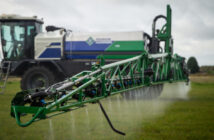‘Lean farming’ has the power to make agricultural operations more effective and improve profit margins – but it requires a radical shift in thinking and is about more than ‘efficiency’.
That’s the message from Conor Colgan, farmer and business consultant who has spent the last ten years pioneering lean farming methods as a result of his MBA Masters Thesis
He’s turned his 800-acre mixed farming business, Aidansfield in Northumberland, into a state-of-the-art beef and cereal research facility underpinned by lean thinking, complete with precision technology and automated operations.
He grows 630 acres of combinable crops and keeps 140 pedigree Salers cows on 165 acres of grassland
Mr Colgan recently hosted a group from 4Sight Farming, a KTIF-funded project to look at the true cost of production when fixed costs are allocated in real time to a crop. As well asrecording labour and machinery hours for analysis and benchmarking, the 30 arable farmers in Scotland are involved in discussion groups assessing different management principles to maximise profitability, including lean farming.
“Lean is doing things simpler with less time but greater effectiveness,” says Mr Colgan. “By looking at your business as a whole ecosystem rather than each process in silos, it eliminates elements that are not adding value to the quality of your delivery. Lean thinking can introduce more predictability into your business and give you the confidence to make management and investment decisions.”
As well as a tour of the new lean-designed farm steading and research facilities – which are a vehicle for farmers, supply companies and processors to trial new methods – Mr Colgan introduced the group to Value Stream Mapping, the intrinsic methodology to lean farming.
He used VSM data from his own enterprises to begin a discussion on how management and investment decisions can be improved with a full grasp of process time, the nature of fixed and variable costs, and their relationship to produce quality delivery.
Eric Anderson, Director of Scottish Agronomy and 4Sight Farming project founder, said : “Lean is a term often used in manufacturing businesses, and this visit has given a valuable practical insight into how it can be applied to an arable or mixed enterprise. It has prompted greater consideration for the relationship between the business’ fixed costs with variable costs and where you can eliminate ‘waste’ in unnecessary activity to streamline your business, without compromising on quality.”
Angus arable and potato farmer Hugh Black said
“Today has validated and formalised what many of us may already be trying to achieve in our own enterprises. It has given me a greater understanding of how we can extend the lean approach from start to end in our business – rather than in isolated processes – in order to drive greater overall efficiency and value. It’s a shift in mindset and the visit and surrounding discussion has given me the confidence to move forward.”
What is ‘lean farming’?
“Lean farming means thinking 100% about your end customer,” says Mr Colgan. “It’s about delivering on this and the alignment of all operations towards it with the minimum time, and cost.
This is different to thinking solely about yield, which can result in not delivering the required grain quality. “It should be a combination of both as buyers buy on quality, and farmers farm on yield,” he warns.
To focus on the customer, Mr Colgan uses ‘Value Stream Mapping’ (VSM): this involves mapping out the operations of each crop area “end to end” with the time it takes to do each task, alongside the fixed, variable costs and value adding potential of the task, culminating in a ‘Current State Map’ of the enterprise. If your end market changes, you need to recreateyour VSM for that enterprise.
Mr Colgan explains “VSM is a wonderful tool as it trains you to think beyond the first obvious steps. For example, cheaper fertiliser may be attractive but if it doesn’t spread well, it diminishes your chances of profit. Moving from ploughing to min till may reduce labour hours but can incur greater herbicide and slug pellet cost. These are examples of not looking at processes in a silo but looking at each one as part of a whole eco-system in your farm.
“Crucially, through analysing the VSM data acquired solely from the point of view of the consumer, it identifies areas of wasted time, resource, loss of value-add and guides the farmer where to eliminate unnecessary activity.”
Through aligning work rates of cultivation, grain drying rate to combine speed and centralising the grain store to the middle of the farm, Mr Colgan has saved over 1000 labour hours- equaling £10,000 costs – during harvest, and now has one worker less at this busy time and less overtime requirement. New grain storage and second-hand grain plant has displaced off farm storage costs and added value to grain equaling £25,000 net per annum.
“Freeing up of time by having good capacity is a good way of eliminating cost within a business and we have found that it has been a major benefit to this farm. Simply adding two furrows to the plough has meant that the ploughing daily work rate is aligned with the power harrowing daily work rate which has embedded predictability to the farm.”
“Chopping straw as opposed to selling straw is more often than not beneficial for organic matter and soil quality but equally creates extra time to drill the crops in optimum conditions by not relying on people to clear the straw by a certain date.”
Lean requires a knowledge of the demand dynamics of your own value chain, says Mr Colgan. For example, he traced the supply chain for his oats, right through to the end customer. Using the lean concept of ‘pull’, he used end demand data combined with UK planting information to deliver a £50 per ton uplift by delaying sale decision.
Principles of ‘lean farming’ implemented via Value Stream Maps at Aidansfield
- Value:Focus on value – 100% delivery of buyer specification every year
- Value Stream: Map how that value is managed through your enterprise systems from a value adding and non-value adding perspective. Measure time, all costs and quality of work and link to product quality achieved.Perform cost/benefit analysis of every process step.
- Flow:Align work rate, capacity of operations, remove unnecessary conveyance and ensure operations optimise ability for crop to maximise yield and quality. Ensure all staff have been well trained with a focus on attention to detail and explain how it is crucial to successful farming.
- Pull: Ensure that your produce has a market and is in demand, cultivate demand for your products and buyer loyalty. If possible choose higher value markets.
- Perfection: Revisit the previous four steps while implementing change, never stop improving to achieve the best net cash position whilesimultaneously delivering 100% of the consumer quality and quantity demanded.




